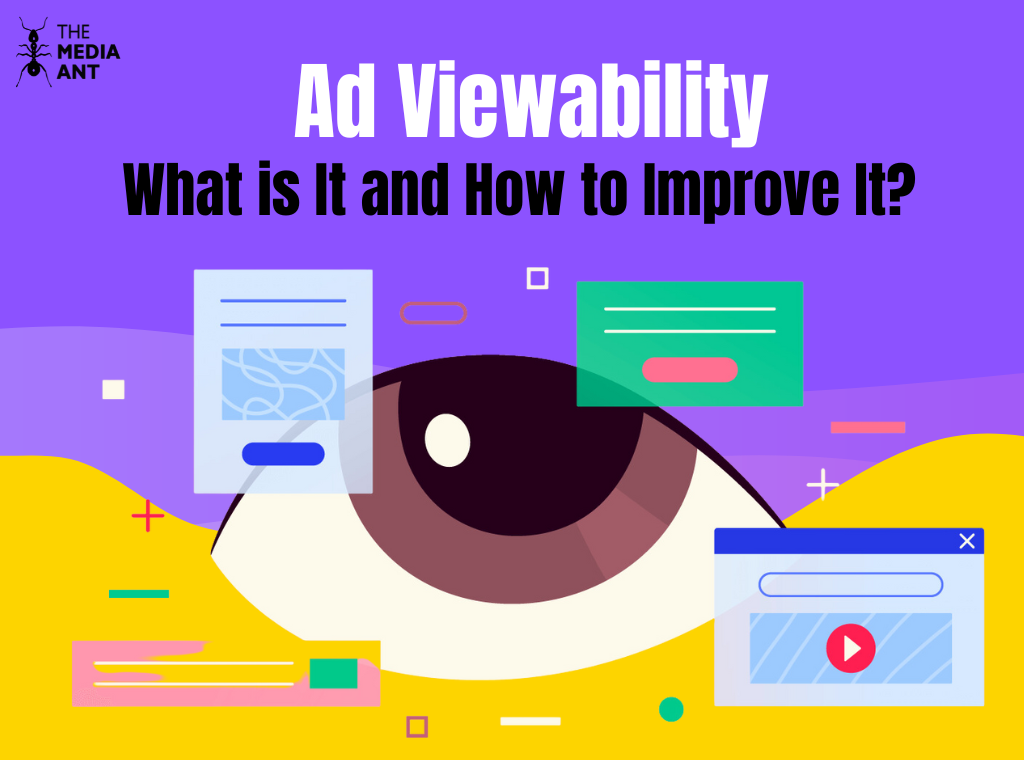Ad viewability is a critical measurement in digital marketing that determines if an ad has the potential to be seen by a user. According to the standards set by the Media Rating Council (MRC) and Interactive Advertising Bureau (IAB), an ad is deemed viewable if at least 50% of its pixels are visible on the screen for a minimum of one continuous second for display ads, and two seconds for video ads. Ensuring high ad viewability rates is essential for maximizing the effectiveness of advertising budgets and increasing the likelihood of user engagement and conversion. However, achieving high viewability levels comes with challenges, such as ad fraud, ad blocking, and strategic ad placement. This blog explores the concept of ad viewability metrics, the factors that impact viewability rates, and effective strategies to improve viewability, offering advertisers valuable insights to optimize their digital campaigns.
Understanding Ad Viewability Metrics
The measurement of ad viewability is crucial in assessing the effectiveness of digital advertising campaigns. The Media Rating Council (MRC) and the Interactive Advertising Bureau (IAB) have established industry standards that define an ad as viewable if at least 50% of its pixels are visible on the screen for a minimum of one continuous second for display ads, and two continuous seconds for video ads. These standards ensure a consistent and standardized approach to evaluating ad performance across the industry.
Key metrics for measuring viewability include viewable impressions, which count the number of ads that meet the viewability criteria. Another important metric is the viewable click-through rate (vCTR), which measures the number of clicks on viewable ads and provides insights into engagement levels. For video ads, the viewable completion rate (VCR) is particularly relevant as it indicates the percentage of viewable ads that are watched until the end.
These metrics enable advertisers to gauge the visibility and interaction of their ads, allowing them to optimize their campaigns for better performance. By focusing on improving these metrics, advertisers can ensure that their ads are not only displayed but also effectively reach and engage their intended audience.
Challenges in Achieving Ad Viewability
Despite its critical importance, achieving high ad viewability rates presents several challenges for advertisers. These challenges can significantly impact the effectiveness of ad campaigns and the overall return on investment (ROI).
1. Ad Fraud:
Ad fraud is one of the most significant challenges, involving malicious practices such as bots generating fake impressions and clicks. This fraudulent activity can artificially inflate viewability metrics, misleading advertisers about the true performance of their campaigns.
2. Ad Blocking:
The widespread use of ad blockers by consumers poses a substantial hurdle. Ad blockers prevent ads from being displayed, thereby reducing the number of viewable impressions. This trend is particularly prevalent among tech-savvy users, diminishing the potential reach of ad campaigns.
3. Ad Clutter:
The digital era is saturated with ads, leading to ad clutter. When too many ads compete for attention on a single page, the likelihood of any individual ad being seen decreases. This overabundance of ads can result in lower viewability rates and reduced user engagement.
4. Non-Human Traffic:
Non-human traffic, such as bots and crawlers, can generate impressions that are not viewable by actual users. This traffic skews viewability metrics and creates a false sense of ad performance, making it challenging for advertisers to gauge the true impact of their campaigns.
5. Discrepancies in Measurement:
Different platforms and vendors may use varying methodologies for measuring viewability, leading to inconsistencies. These discrepancies can make it difficult for advertisers to compare performance across different channels and achieve a holistic understanding of their ad viewability.
6. Poor Ad Placement:
Ads placed in less visible areas of a webpage, such as below the fold or in sidebars, are less likely to be seen by users. Ensuring optimal ad placement is crucial for improving viewability rates, but it often requires negotiation with publishers and a deep understanding of user behavior on specific sites.
Addressing these challenges requires a multifaceted approach, combining advanced technology, strategic planning, and continuous optimization to ensure that ads are viewable and effective.
Factors Affecting Viewability Rates
Ad viewability rates are influenced by a multitude of factors, each playing a critical role in determining whether an ad is seen by its intended audience. Understanding these factors is essential for optimizing ad campaigns to achieve higher viewability rates.
1. Ad Format:
Different ad formats have varying impacts on viewability. For example, video ads generally have higher viewability rates compared to display ads because they often occupy a more prominent position on the screen and require user interaction to play.
2. Placement on the Page:
The position of an ad on a webpage significantly affects its viewability. Ads placed above the fold—visible without scrolling—are more likely to be seen than those placed below the fold. Additionally, ads located near engaging content, such as articles or videos, tend to have higher viewability.
3. Page Load Time:
Slow-loading pages can hinder ad viewability. If an ad takes too long to load, users may navigate away from the page before the ad appears. Ensuring quick load times for ads is crucial for maintaining high viewability rates.
4. User Behavior:
User interaction with the webpage plays a vital role. Users who quickly scroll past content or leave the page shortly after it loads are less likely to view ads. Understanding and predicting user behavior can help optimize ad placement and format.
5. Ad Size:
Larger ads typically have higher viewability rates because they occupy more screen space and are harder to ignore. Full-screen ads and those with high visibility on mobile devices are particularly effective.
6. Page Layout and Design:
The overall design and layout of the webpage can influence ad viewability. Websites with clean, organized layouts are more likely to present ads in a viewable manner compared to cluttered, poorly designed pages.
7. Device Type:
The type of device used to view the ad also affects viewability. Mobile devices, for instance, often present different challenges and opportunities for ad viewability compared to desktops. Responsive design that adapts to different screen sizes is crucial for maintaining high viewability across all devices.
8. Frequency and Ad Clutter:
The number of ads displayed on a single page can impact viewability. Pages overcrowded with ads may lead to ad fatigue, where users ignore or scroll past ads without viewing them. Limiting the number of ads and strategically placing them can enhance viewability rates.
9. Publisher Quality:
The reputation and quality of the publisher also play a role. High-quality, reputable publishers are more likely to adhere to best practices for ad placement and page design, leading to higher viewability rates.
Strategies to Improve Ad Viewability
Enhancing ad viewability is essential to optimize the efficiency of digital advertising campaigns. Through the utilization of tailored tactics, advertisers can increase the chances of their ads being viewed by the desired audience, ultimately leading to improved engagement and ROI. Below are fundamental strategies to boost ad viewability:
1. Optimize Ad Placement:
- Above the Fold: Place ads in areas that are immediately visible when the page loads, known as “above the fold.” These positions are prime real estate for ensuring higher viewability.
- Near Engaging Content: Position ads next to engaging content such as articles, videos, or interactive elements to increase the chances that users will see the ads.
2. Improve Page Load Speed:
- Reduce Load Times: Ensure that ads load quickly by optimizing the website’s performance. Slow-loading pages can lead to lower viewability as users may navigate away before the ad fully appears.
- Lazy Loading: Implement lazy loading for ads, where ads load only when they are about to come into the user’s viewport, reducing initial load times and improving the user experience.
3. Use High-Impact Ad Formats:
- Video Ads: Utilize video ads, which typically have higher viewability rates compared to static display ads. Ensure that video ads meet the MRC standards (at least 50% of pixels in view for two continuous seconds).
- Large and Full-Screen Ads: Employ larger ad units or full-screen formats that dominate the viewing area and capture user attention more effectively.
4. Leverage Responsive Design:
- Mobile Optimization: Ensure that ads are responsive and optimized for various devices, especially mobile. Mobile users represent a significant portion of web traffic, and ads must be viewable across all screen sizes.
- Adaptive Ads: Create ads that adjust dynamically based on the user’s device and screen orientation to maintain high viewability.
5. Reduce Ad Clutter:
- Limit Ad Density: Avoid overcrowding web pages with too many ads. A cleaner page with fewer, well-placed ads can lead to higher viewability rates.
- Strategic Ad Rotation: Use frequency capping and strategic ad rotation to prevent ad fatigue and ensure each ad has a better chance of being seen.
6. Implement Viewability Measurement Tools:
- Real-Time Monitoring: Utilize tools that offer real-time monitoring of ad viewability. Platforms like Moat, Integral Ad Science (IAS), and DoubleVerify provide insights and metrics to help optimize ad placements.
- Verification Services: Employ third-party verification services to ensure that ads are viewable and that ad fraud is minimized.
7. Enhance Ad Creative:
- Engaging Content: Design visually appealing and interactive ad creatives that draw user attention. Use strong calls-to-action (CTAs) and engaging visuals to increase interaction.
- Contextual Relevance: Ensure that ad content is relevant to the surrounding content on the webpage, enhancing the likelihood that users will engage with the ad.
8. Collaborate with Quality Publishers:
- High-Quality Inventory: Partner with reputable publishers known for maintaining high standards in ad placement and user experience. Quality publishers are more likely to adhere to best practices that enhance ad viewability.
- Direct Deals: Engage in direct deals with publishers to secure premium ad placements and reduce reliance on programmatic buying, which can sometimes result in less optimal placements.
Leveraging Technology and Tools
In the quest to improve ad viewability, advertisers can leverage a range of advanced technology and tools to enhance their campaigns. Two key categories of tools stand out: ad verification and measurement platforms, and viewability reporting and analysis.
1. Ad Verification and Measurement Platforms
Ad verification and measurement platforms play a pivotal role in assessing and ensuring ad viewability. These platforms provide advertisers with the capability to monitor ad placements, detect ad fraud, and verify that ads are being served to real human users. By leveraging features such as real-time monitoring and fraud detection algorithms, advertisers can gain valuable insights into ad viewability and take proactive measures to optimize their campaigns.
2. Viewability Reporting and Analysis
Viewability reporting and analysis tools enable advertisers to track and analyze the performance of their ad campaigns in terms of viewability metrics. These tools provide detailed reports and visualizations that highlight key metrics such as viewable impressions, viewability rates, and engagement levels. By closely analyzing these metrics, advertisers can identify trends, pinpoint areas for improvement, and make data-driven decisions to enhance ad viewability and overall campaign effectiveness.
Best Practices for Enhancing Ad Viewability
To further enhance ad viewability, advertisers can implement best practices focused on designing engaging and relevant ads, as well as implementing responsive design.
1. Designing Engaging and Relevant Ads
Creating ads that capture user attention and resonate with the target audience is essential for maximizing ad viewability. Advertisers should focus on crafting visually appealing creatives, incorporating compelling messaging, and ensuring relevance to the context in which the ads are displayed. By aligning ad content with user interests and preferences, advertisers can increase the likelihood of ad engagement and improve viewability rates.
2. Implementing Responsive Design
Responsive design is critical for ensuring that ads are optimized for viewing across various screen sizes and devices. Advertisers should prioritize the implementation of responsive design techniques to adapt ad formats and layouts dynamically based on the user’s device and screen orientation. By delivering a seamless and consistent user experience across devices, advertisers can enhance ad viewability and drive better campaign performance.
Conclusion
In conclusion, the visibility of ads plays a crucial role in the effectiveness of digital advertising. It ensures that ads have the chance to be seen by users, which is essential in a world filled with challenges like ad fraud, ad blocking, and different measurement methodologies. To achieve high viewability rates, a strategic and proactive approach is necessary. This includes optimizing ad placement, embracing impactful ad formats, utilizing responsive design, and collaborating with reputable publishers. By doing so, advertisers can improve ad viewability and maximize the effectiveness of their campaigns. Furthermore, the use of advanced measurement tools and continuous optimization efforts are vital for staying ahead in the ever-changing digital advertising ecosystem. By prioritizing ad viewability, advertisers can drive better engagement, increase brand visibility, and ultimately achieve their marketing objectives in the competitive digital marketplace.
FAQs on Ad Viewability
What is the best viewability for ads?
The industry standard for ad viewability, set by organizations like the Media Rating Council (MRC) and the Interactive Advertising Bureau (IAB), defines an ad as viewable if at least 50% of its pixels are in view for a minimum continuous duration. However, aiming for as close to 100% viewability as possible is ideal for maximizing the effectiveness of ad campaigns.
Why is ad viewability important?
Ad viewability is crucial because it ensures that advertisers are paying for ads that have the opportunity to be seen by users. By prioritizing viewability, advertisers can maximize the impact of their advertising spend, increase brand visibility, and drive better engagement with their target audience.
What is the formula for viewability?
The standard formula for calculating viewability rate is (total viewable impressions / total impressions) x 100
What are viewability examples?
Viewability examples include metrics such as viewable impressions, viewable completion rate (VCR), viewable click-through rate (vCTR), and viewable time spent. These metrics provide insights into the extent to which ads are seen and engaged with by users, helping advertisers evaluate the effectiveness of their campaigns.
What is viewability in an ad manager?
Viewability in an ad manager refers to the measurement and optimization of ad viewability within an ad management platform. Ad managers typically offer tools and features for monitoring ad viewability, analyzing performance metrics, and optimizing ad placements to maximize viewability rates. By leveraging viewability data in ad managers, advertisers can make informed decisions to improve campaign effectiveness and achieve their advertising goals.





